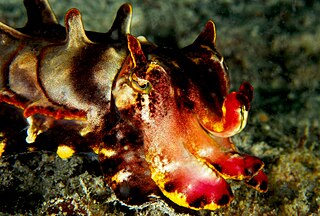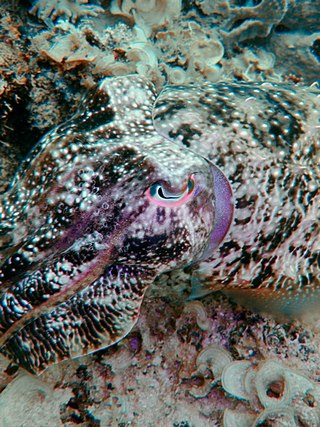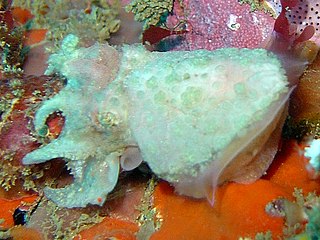
True squid are molluscs with an elongated soft body, large eyes, eight arms, and two tentacles in the superorder Decapodiformes, though many other molluscs within the broader Neocoleoidea are also called squid despite not strictly fitting these criteria. Like all other cephalopods, squid have a distinct head, bilateral symmetry, and a mantle. They are mainly soft-bodied, like octopuses, but have a small internal skeleton in the form of a rod-like gladius or pen, made of chitin.

A cephalopod is any member of the molluscan class Cephalopoda such as a squid, octopus, cuttlefish, or nautilus. These exclusively marine animals are characterized by bilateral body symmetry, a prominent head, and a set of arms or tentacles modified from the primitive molluscan foot. Fishers sometimes call cephalopods "inkfish", referring to their common ability to squirt ink. The study of cephalopods is a branch of malacology known as teuthology.

Metasepia pfefferi, also known as the flamboyant cuttlefish, is a species of cuttlefish occurring in tropical Indo-Pacific waters off northern Australia, southern New Guinea, as well as numerous islands of the Philippines, Indonesia and Malaysia. The flesh of this colorful cephalopod contains unique acids, making it unsuitable for consumption.

Sepia latimanus, also known as the broadclub cuttlefish, is widely distributed from the Andaman Sea, east to Fiji, and south to northern Australia. It is the most common cuttlefish species on coral reefs, living at a depth of up to 30 m.

The common cuttlefish or European common cuttlefish is one of the largest and best-known cuttlefish species. They are a migratory species that spend the summer and spring inshore for spawning and then move to depths of 100 to 200m during autumn and winter. They grow to 49 cm in mantle length (ML) and 4 kg in weight. Animals from subtropical seas are smaller and rarely exceed 30 cm in ML.

The pharaoh cuttlefish is a large cuttlefish species, growing to 42 cm in mantle length and 5 kg in weight. It is also known as seiche pharaon.

Sepia mestus, also known as the reaper cuttlefish or red cuttlefish, is a species of cuttlefish native to the southwestern Pacific Ocean, specifically Escape Reef off Queensland to Murrays Beach off Jervis Bay. Reports of this species from China and Vietnam are now known to be misidentifications. S. mestus lives at a depth of between 0 and 22 m.
Sepia australis, the southern cuttlefish, is a species of cuttlefish which is found in the eastern South Atlantic Ocean and the western Indian Ocean off the coasts of Southern Africa, possibly extending into the waters off East Africa.
Sepia hedleyi, or Hedley's cuttlefish, is a species of cuttlefish in the family Sepiidae, endemic to subtropical and temperate waters off Australia.

Sepia tuberculata is a species of cuttlefish native to South African waters from Melkbosstrand to Knysna. It belongs to the genus Sepia. It lives in very shallow water to a depth of 3 m. It is endemic.

Cuttlefish or cuttles are marine molluscs of the order Sepiida. They belong to the class Cephalopoda which also includes squid, octopuses, and nautiluses. Cuttlefish have a unique internal shell, the cuttlebone, which is used for control of buoyancy.
Sepia trygonina, the trident cuttlefish, is a species of cuttlefish in the genus Sepia from the Red Sea and the western Indian Ocean. Cuttlefish are a specific type of cephalopod that is a highly evolved branch of the Mollusca phylum. They are characterized by having a calcareous shell that is covered by a membrane with free fin lobes that are laterally placed on both sides of their head. They have a centered beak that is used for feeding which is surrounded by 10 appendages. The trident cuttlefish are carnivores that prey on fish, crustaceans, and shellfish. They are also a major source of food for larger marine life like dolphins, seals, and even birds.

Sepia prashadi, common name hooded cuttlefish, is a widely distributed species of cuttlefish. It has a thin, oval body and grows from 5 to 11 cm. The tips of the tentacles have a distinct club shape. S. prashadi is a migratory, demersal cuttlefish living in shallow waters at depths of approximately 40 to 50 metres. It is found in many locations including the east coast of Africa, around India, in the Red Sea, and Persian Gulf.
Sepia braggi, the slender cuttlefish, is a species of cuttlefish native to the Indo-Pacific Ocean. It has been found in coastal waters of southern Australia. This species was first collected in South Australia by its namesake, William Lawrence Bragg. Sepia braggi was then described by Sir Joseph Cooke Verco in 1907.Sepia braggi is part of the subgenus Doratosepion which contains to 41 species of cuttlefish in total.

Sepia elegans, the elegant cuttlefish, is a species of cuttlefish in the family Sepiidae from the eastern Atlantic Ocean and the Mediterranean Sea. It is an important species for fisheries in some parts of the Mediterranean where its population may have suffered from overfishing.
Sepia bertheloti, the African cuttlefish, is a species of cuttlefish from the family Sepiidae which is found in the warmer waters of the eastern Atlantic Ocean off Africa.
Sepia hierredda, the giant African cuttlefish, is a species of cuttlefish from the family Sepiidae, which was previously considered conspecific with the common cuttlefish Sepia officinalis. It is found along the western coast of Africa and is an important species to fisheries.

Sepioloidea lineolata or more commonly known as the striped pyjama squid or the striped dumpling squid is a type of bottletail squid, that inhabits the Indo-Pacific Oceans of Australia. Although it is not quite a cuttlefish, as it does not have a cuttlebone, it is otherwise exactly the same as cuttlefish. Therefore it is a sepioid, not a real cuttlefish. However, it is usually referred to as a cuttlefish for public simplification. It is not a squid either. The striped pyjama squid lives on the seafloor and is both venomous and poisonous. When fully mature, a striped pyjama squid will only be about 7 to 8 centimeters in length. Baby striped pyjama squids can be smaller than 10mm.

Sepia bandensis, commonly known as the stumpy-spined cuttlefish or dwarf cuttlefish, is a species of cuttlefish. Sepia baxteri and Sepia bartletti are possible synonyms. It reaches 7 centimeters in mantle length; males weigh about 40 grams, females 45 grams. The body is coloured light brown, or greenish yellow, with white spots on the head and short white bars on the dorsal mantle. The fins, of pale colour, have rows of small fluorescent blue spots.















